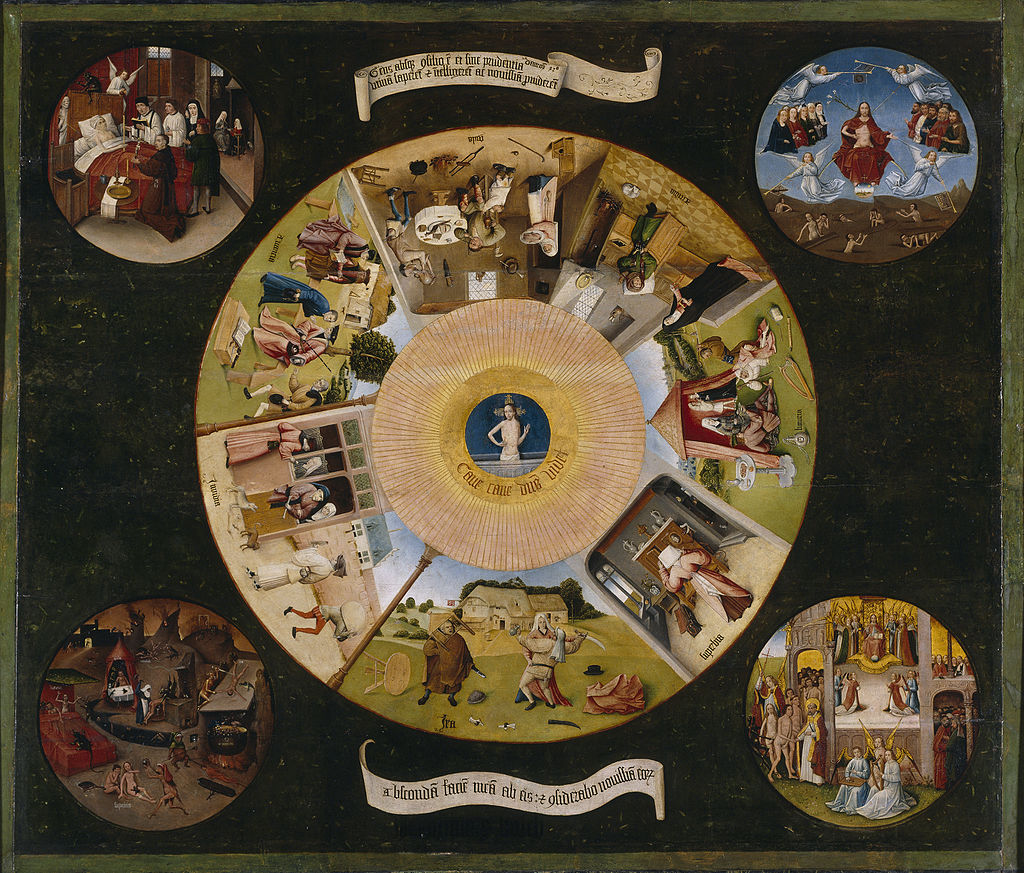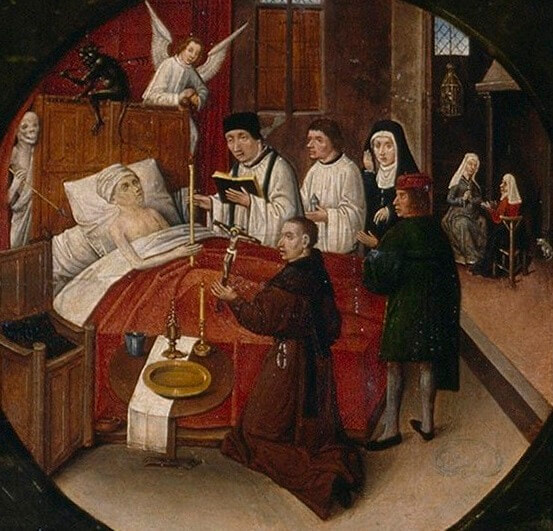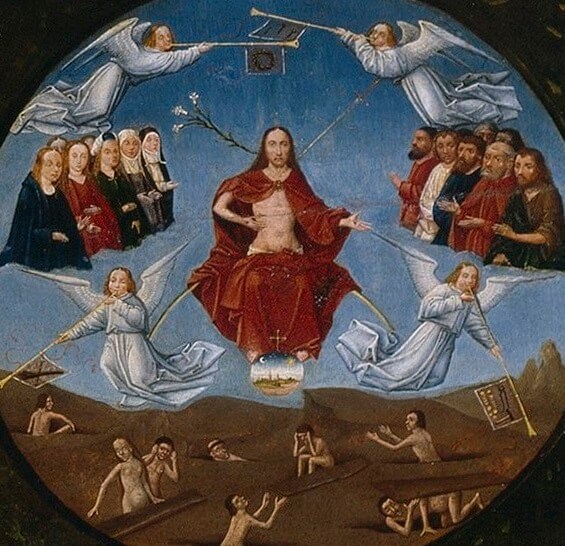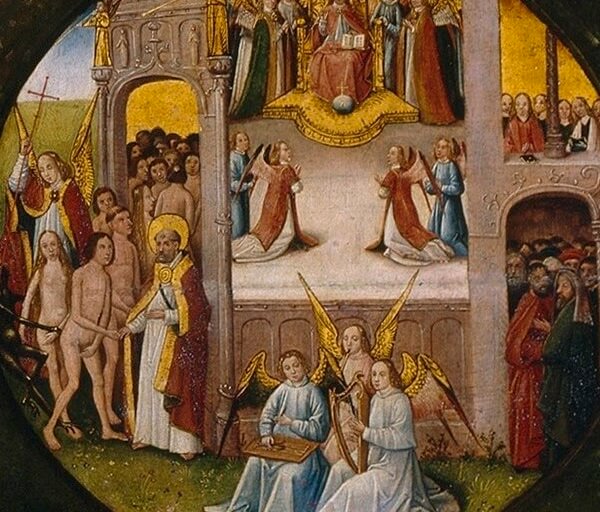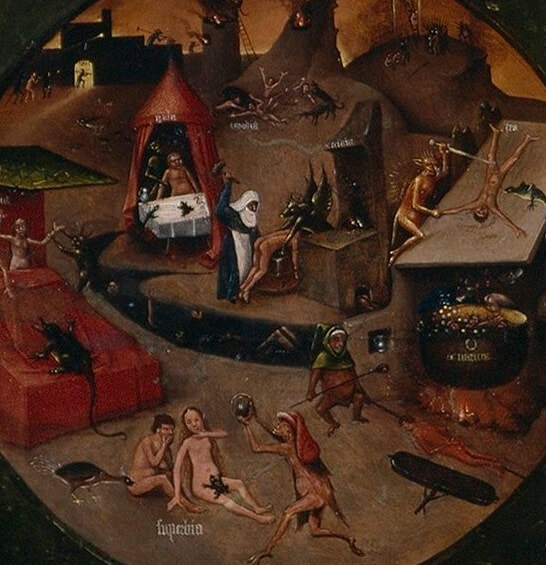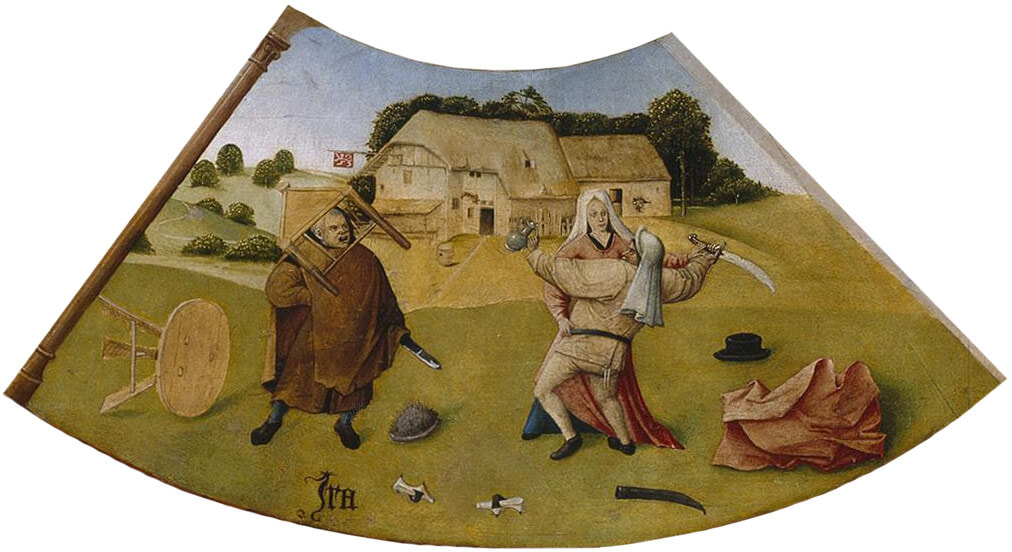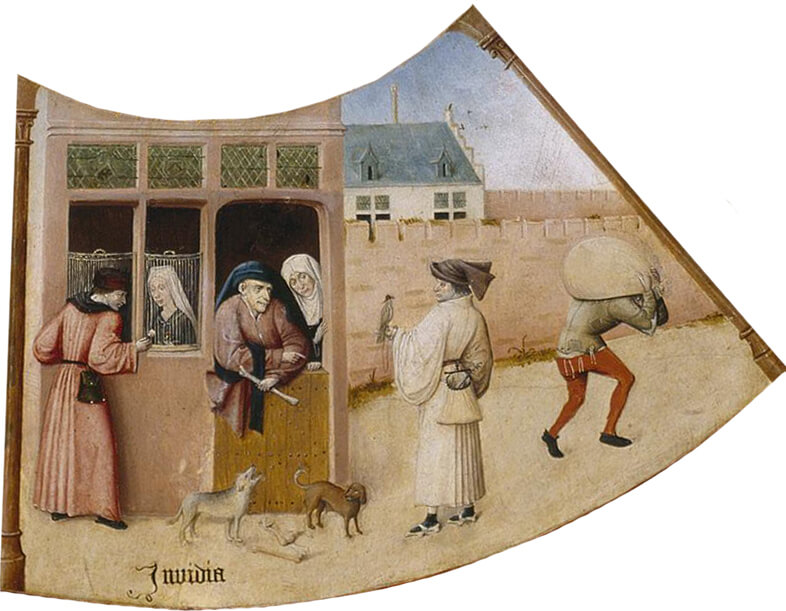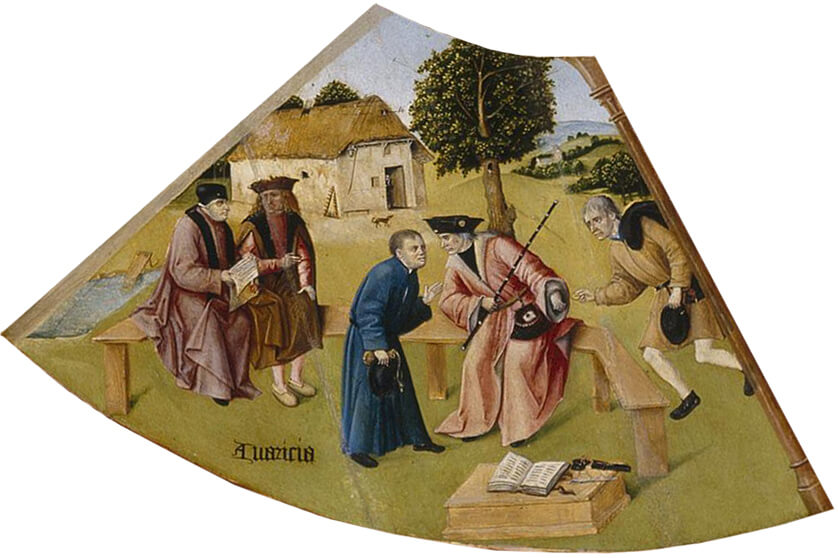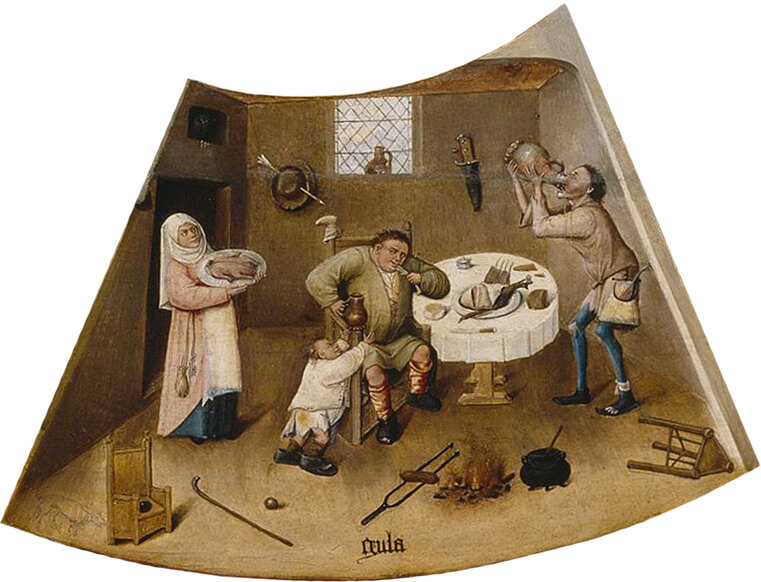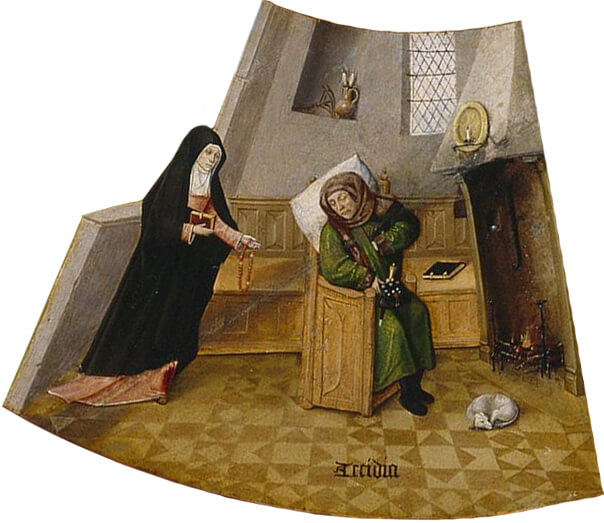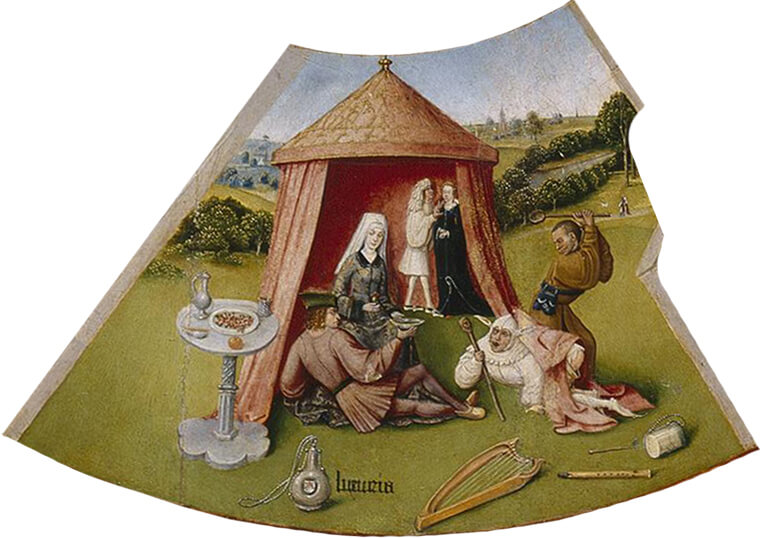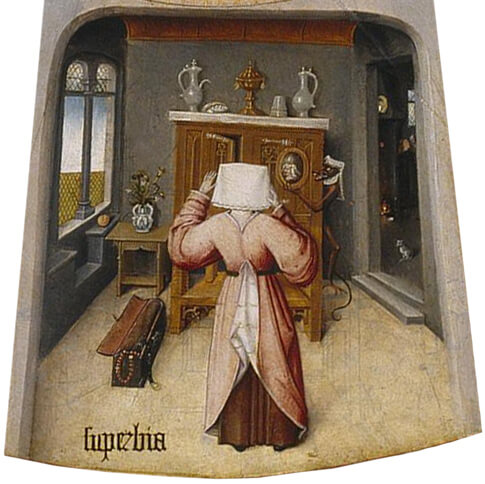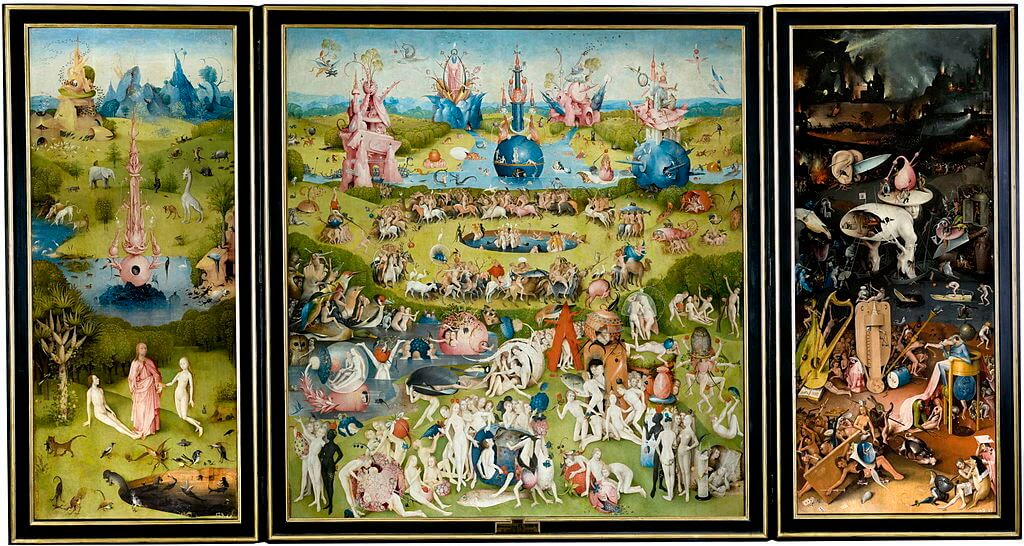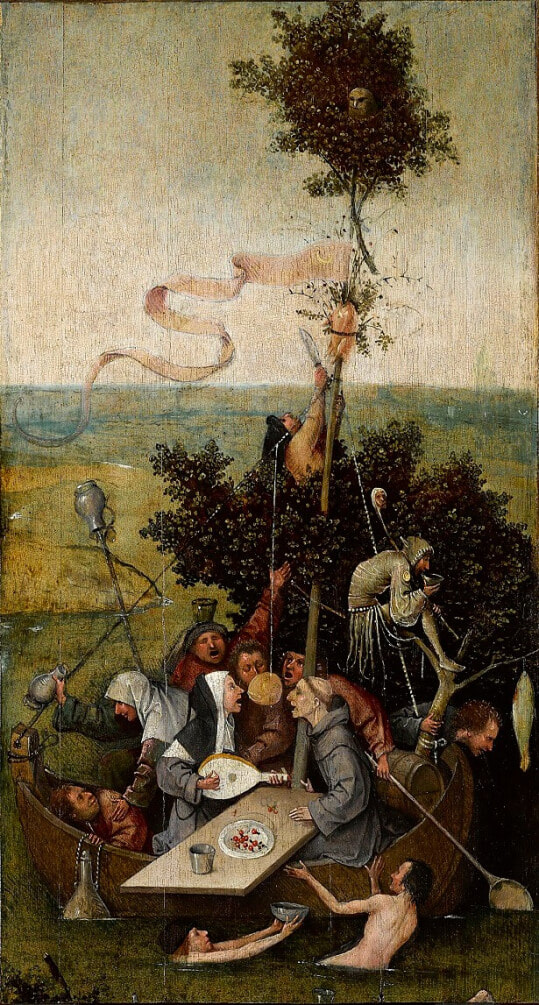|
Where? Room 56a of the Prado Museum
When? Probably around 1500 What do you see? Bosch painted this work on a wooden tabletop. On the outside are four circles with the four things of man, which are the last four stages that the human soul goes through upon death. In the middle is a large circle with scenes of the seven sins. In the center is an image of Christ emerging from his grave with the text ‘Cave cave dns videt’, which means ‘Beware, beware, the Lord sees’. The banderol on the top shows a text from Deuteronomy 32:28 – “They are foolish. They don’t understand. If they were wise, they would understand; they would know what would happen to them.” The banderol at the bottom contains a text from Deuteronomy 32:20 – “I will turn away from them, then let’s see what happens!”. The four last things: The last four things are discussed clockwise starting at the left top.
(Click on each of the images below to enlarge them)
The seven sins: The sins discussed are discussed clockwise starting at the bottom.
(Click on each of the images below to enlarge them)
Fun fact: The Prado Museum claims that Hieronymus Bosch created this painting. However, there is some discussion on whether this claim is valid, as others people believe that this painting is created by one of the followers of Bosch. One argument in favor of Bosch is that the painting contains his name, just below the banderol in the bottom center. An argument against Bosch is that there is already documentation in the 16th century that a pupil of Bosch created this painting and that he either added the name of Bosch out of respect for his master or to increase the value of the painting.
The main reason for doubt, though, is that this painting is not very typical for Bosch. The figures in this painting are somewhat unrefined, something that is not the case in the other works attributed to Bosch. Another reasonable explanation is that Bosch painted this work together with his assistants as some scenes are of higher quality than others. Interested in a copy for yourself? Poster.
0 Comments
Where? Gallery 41 of the National Gallery of Art
When? Between 1485 and 1516 What do you see? The final moments of the life of a miser, who is a stingy person collecting a lot of wealth. The painting consists of three scenes.
Symbolism: The moral message of this painting is a warning against greed. Humans often face the tradeoff between earthly wealth, also referred to as avarice, and faith. The items in the trunk (the dagger, metal cups, and the golden weight) represent various items that people pawned when they were in need of money. These items were typically pawned against a high interest rate, which was against the laws of the Church.
Who is Bosch? Hieronymus Bosch, also known as Jhernoymus or Jeroen Bosch, was born around 1450 under the name Jheronymus van Aken in ‘s-Hertogenbosch, in the south of The Netherlands. He also died there in 1516. He was an innovative painter who found novel ways to depict existing themes. He is especially known for his satiric paintings. Not too much is known about his life and therefore there is also a lot of debate whether Bosch really created certain paintings and when he created them. However, his innovative works have had a big influence on future painters, such as Pieter Bruegel the Elder and Salvador Dalí. His most famous work is the Garden of Earthly Delights in the Prado Museum in Madrid.
Fun fact: Based on infrared pictures, various adjustments to this painting by Bosch have been discovered. For example, in the underdrawing, the miser initially held a covered goblet that he seemed to offer to the figure of Death near the door. This would be an obvious clue that the miser wanted to offer Death some earthly wealth to change his decision. In the final version of the painting, the miser is looking at Death while pointing with his right hand to the money bag that is held by the devil. This clue is a bit more ambiguous but still suggests that the miser wants to offer money to Death. Another example is that the underdrawing shows the inclusion of a flask with drinking glasses and a rosary in the scene in the foreground.
Interested in a copy for yourself? Poster. |
Categories
All
|
- Home
- Blog
-
Museums
- Alte Pinakothek
- Art Institute of Chicago
- Baltimore Museum of Art
- Barber Institute of Fine Arts
- Bargello
- Barnes Foundation
- British Museum
- Church of Sant’Anastasia
- Cleveland Museum of Art
- Courtauld Institute of Art
- Detroit Institute of Arts
- Frans Hals Museum
- Galleria Borghese
- Gallerie dell'Accademia
- Getty Museum
- Guggenheim
- Hermitage Museum
- Kunsthistorisches Museum
- Kunstmuseum Basel
- Legion of Honor Museum
- Louvre
- Mauritshuis
- Metropolitan Museum of Art
- Musee d’Orsay
- Museum of Fine Arts in Boston
- Museum of Modern Art
- National Gallery in London
- National Gallery of Art
- National Museum in Poznań
- Norton Simon Museum
- Ny Carlsberg Glyptotek
- Palace of Versailles
- Palazzo Pitti
- Palazzo Vecchio
- Petit Palais
- Philadelphia Museum of Art
- Prado
- Pushkin Museum
- Ravenna Art Museum
- Rijksmuseum
- San Diego Museum of Art
- Santa Maria delle Grazie
- St. Peter's Basilica
- Städel Museum
- Statens Museum for Kunst
- Tate Britain
- Tate Modern
- Timken Museum of Art
- Uffizi
- Vatican Museums
- Wallace Collection
-
Artists
- Altdorfer
- Anguissola
- Berlin Painter
- Bosch
- Botticelli
- Boucher
- Bronzino
- Bruegel the Elder
- Brunelleschi
- Cabanel
- Caillebotte
- Canova
- Caravaggio
- Carpeaux
- Cezanne
- Cimabue
- David
- Degas
- Delacroix
- De Maria
- Donatello
- El Greco
- Fontana
- Fra Angelico
- Fragonard
- Gauguin
- Gentileschi
- Gericault
- Gonzalez-Torres
- Goya
- Hals
- Hogarth
- Hokusai
- Ingres
- Leonardo da Vinci
- Lippi, Filippo
- Longhi, Barbara
- Lorrain
- Makovsky
- Manet
- Massys
- Matisse
- Merian
- Michelangelo
- Mochi
- Modigliani
- Monet
- Panini
- Parmigianino
- Perugino
- Picasso
- Pisanello
- Raphael
- Rembrandt
- Renoir
- Reynolds
- Rivera
- Rodin
- Rubens
- Scultori
- Seurat
- Steen
- Tintoretto
- Titian
- Toulouse-Lautrec
- Turner
- Uccello
- Van der Weyden
- Van Dyck
- Van Eyck
- Van Gogh
- Van Hemessen
- Vasari
- Velazquez
- Vermeer
- Veronese
- Vigée Le Brun
-
Locations
- Books
- About Us

